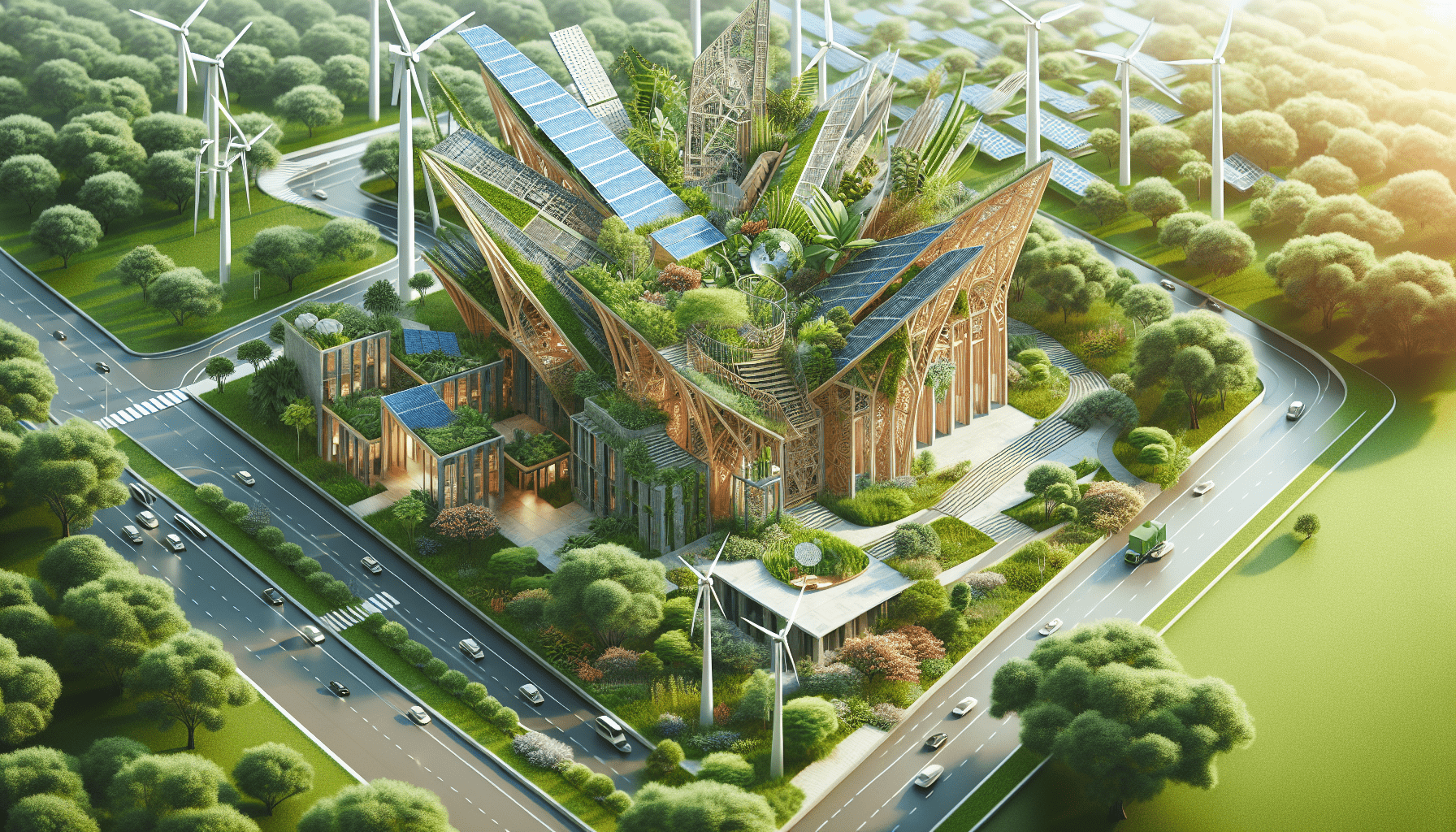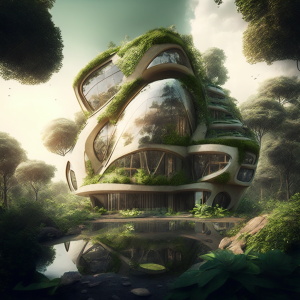In our journey toward a more sustainable future, cradle-to-cradle design has emerged as a pivotal concept in sustainable architecture. This innovative approach challenges us to rethink how we design buildings and the materials we use, ensuring that every element can be repurposed or returned safely to the environment at the end of its life cycle. By embracing this philosophy, we aren’t just minimizing waste; we’re fostering a circular economy that promotes regeneration and renewal. Have you ever wondered how architecture can be part of a sustainable future? Well, we have some fascinating insights for you! Let’s dive into the world of cradle-to-cradle design in sustainable architecture. This concept not only seeks to minimize waste but also creates structures that can have a positive impact on our environment.
What Is Cradle-to-cradle Design?
Cradle-to-cradle (C2C) design is a revolutionary approach to sustainability that goes beyond the traditional reduce, reuse, and recycle model. Instead of viewing materials as being “used up” and discarded, C2C promotes the idea of viewing everything as a nutrient that can either return to the earth safely or be upcycled into new products. In essence, it’s a closed-loop system where waste equals food, meaning every output can be turned back into an input.
The Origins of Cradle-to-cradle
The concept was introduced by chemist Michael Braungart and architect William McDonough. Their collaboration led to the publication of the book “Cradle to Cradle: Remaking the Way We Make Things” in 2002. They promoted the idea that it is possible to create a world where industry and ecology can coexist harmoniously.
Key Principles
Three main principles define cradle-to-cradle design:
- Waste Equals Food: Everything in a successful cradle-to-cradle system is designed with future use in mind. Technical nutrients (industrial materials) and biological nutrients (natural materials) are kept in separate, continuous cycles.
- Use of Renewable Energy: Energy should come from renewable sources, such as solar, wind, and water. This limits or eliminates the use of non-renewable energy sources.
- Celebrate Diversity: Rather than a one-size-fits-all approach, diversity in design and solutions is encouraged. This includes using a variety of local materials, designs that reflect cultural diversities, and fostering biodiversity.
The Application of Cradle-to-cradle in Architecture
When we look at how cradle-to-cradle principles can be applied to architecture, it opens up a whole new dimension of sustainable building practices. It’s not just about reducing the carbon footprint of a building but also about creating structures that introduce positivity into their environment.
Materials Management
In sustainable architecture, choosing materials is crucial. Cradle-to-cradle design mandates that all materials used in construction are either biodegradable or recyclable. This necessitates a thorough understanding of what happens to these materials after the building’s life cycle concludes.
Energy Efficiency
Sustainable architecture aims to create structures that are energy efficient. By using renewable energy sources for heating, cooling, and electricity, buildings can significantly reduce their dependency on fossil fuels.
Water Conservation
Water efficiency is a critical aspect. Architects design systems to collect rainwater, utilize greywater for landscaping, and install low-flow fixtures to minimize water usage.
Creating Positive Footprints
One of the most exciting aspects of cradle-to-cradle design is its potential to create building environments that contribute positively to their surroundings. This could mean implementing green roofs, vertical gardens, and other forms of urban agriculture.
Benefits of Cradle-to-cradle Design in Architecture
Embracing cradle-to-cradle principles in architecture can lead to a wide array of benefits. These advantages are not only confined to environmental impacts but also extend to social and economic realms.
Environmental Benefits
- Waste Reduction: By ensuring that materials are either compostable or recyclable, cradle-to-cradle design significantly reduces waste.
- Biodiversity: Incorporating green spaces within and around buildings supports local wildlife and plant species.
- Lower Carbon Footprint: Buildings designed with renewable energy sources and sustainable materials result in a much smaller carbon footprint.
Economic Benefits
- Cost-Effective Over Time: Although initial investments might be higher, cradle-to-cradle buildings are cost-effective over their lifecycle due to reduced energy and water costs.
- Job Creation: Developing new technologies and materials for sustainable architecture creates new job opportunities.
Social Benefits
- Healthier Living Spaces: Buildings that use non-toxic, eco-friendly materials contribute to healthier indoor environments.
- Enhanced Quality of Life: Incorporating natural light, green areas, and good ventilation improves overall well-being.
Real-world Examples
Many projects across the globe have successfully implemented cradle-to-cradle design principles. These buildings stand as testaments to what sustainable architecture can achieve.
The Bullitt Center, Seattle
Known as the “greenest commercial building in the world,” the Bullitt Center utilizes an array of cradle-to-cradle ideas. It generates its energy through solar panels and collects rainwater to meet its water needs. The structure is designed to last 250 years, reducing the need for reconstruction.
Park 20|20, Netherlands
Park 20|20 is a pioneering business park developed with cradle-to-cradle principles. It focuses on creating a pleasant and healthy environment using sustainable materials and renewable energy. The buildings are designed for easy disassembly, allowing materials to be repurposed at the end of their life cycle.
The Edge, Amsterdam
The Edge is an office building that showcases a sustainable future. Its design includes energy-efficient systems, photovoltaic panels, and an advanced climate control system that learns and adapts to occupancy patterns.
| Project Name | Location | Key Features |
|---|---|---|
| Bullitt Center | Seattle | Solar panels, rainwater collection, 250-year lifespan |
| Park 20 | 20 | Netherlands |
| The Edge | Amsterdam | Energy-efficient, photovoltaic panels, adaptive climate system |
Challenges and Considerations
Despite its many benefits, implementing cradle-to-cradle design in architecture comes with challenges that must be addressed.
Higher Initial Costs
One of the most significant barriers is the higher initial cost of development. Renewable energy systems, sustainable materials, and innovative designs can require more investment upfront. However, these costs are typically offset over time through energy and water savings.
Awareness and Education
There is a need for increased awareness and education about the cradle-to-cradle concept. Many developers and architects are still unfamiliar with these principles, leading to slow adoption.
Regulatory Barriers
Building codes and regulations in some regions might not yet support or encourage the use of cradle-to-cradle practices. Updating these to facilitate sustainable design is a key step.
Material Availability
Access to high-quality, certified cradle-to-cradle materials can be limited. The industry needs to expand its supply chains and certifications to meet growing demand.
The Future of Cradle-to-cradle Design
The future of sustainable architecture lies in integrating cradle-to-cradle principles at every stage of building design and construction. As technology advances, we can expect to see more innovative solutions that enhance sustainability while meeting the needs of modern life.
Advancements in Technology
Advanced technologies such as 3D printing, smart materials, and AI-driven building management systems are expected to play significant roles in promoting cradle-to-cradle design. These technologies can optimize material usage, enhance energy efficiency, and simplify the building process.
Policies and Incentives
Governments and organizations are beginning to recognize the importance of sustainable design and are implementing policies and incentives. Grants, tax breaks, and credits for green building projects can encourage more developers to adopt cradle-to-cradle principles.
Collaboration and Community Efforts
A collaborative approach is essential for the widespread adoption of cradle-to-cradle design. Architects, developers, communities, and governments need to work together to share knowledge, resources, and best practices.
How We Can Support Cradle-to-cradle Design
Supporting cradle-to-cradle design involves making conscious choices and advocating for sustainable practices in our communities.
Choosing Sustainably
When constructing or renovating, we should choose materials and systems that adhere to cradle-to-cradle principles. This includes opting for renewable energy sources, non-toxic materials, and systems designed for efficiency.
Advocating for Policy Changes
We can advocate for policy changes that support sustainable architecture. By engaging with local governments and participating in community planning efforts, we can push for regulations that promote cradle-to-cradle design.
Spreading Awareness
Education plays a critical role. By spreading awareness about the benefits and principles of cradle-to-cradle design, we can inspire more individuals and organizations to adopt these practices.
Supporting Research and Development
Funding and supporting research into new materials and technologies that align with cradle-to-cradle principles can drive innovation and make sustainable building practices more accessible and widespread.
Conclusion
Cradle-to-cradle design in sustainable architecture is more than a trend; it’s a necessary evolution for our built environment. By embracing the principles of waste equals food, renewable energy use, and celebrating diversity, we can create buildings that are not only less harmful to our planet but indeed beneficial. This approach fosters a healthier living environment, preserves natural resources, and supports economic growth through sustainable practices.
While challenges exist, the benefits of cradle-to-cradle design far outweigh them. With continued innovation, policy support, and community engagement, we can work towards a future where our buildings are part of a regenerative cycle, helping to restore and sustain our planet for generations to come. So, let’s take action and be part of this exciting journey towards truly sustainable architecture.




